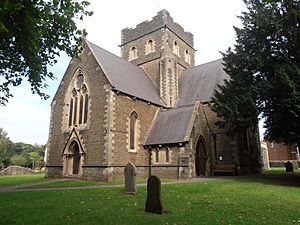St Margaret's Church, Roath facts for kids
Quick facts for kids St Margaret of Antioch |
|
|---|---|
|
Eglwys y Santes Fererid
|
|
 |
|
| 51°29′34″N 3°09′17″W / 51.4929°N 3.1547°W | |
| Denomination | Church in Wales |
| Previous denomination | Roman Catholic |
| Website | The |
| History | |
| Status | Active |
| Founded | 11th century |
| Dedication | St Margaret of Antioch |
| Architecture | |
| Functional status | Mother church |
| Heritage designation | Grade I |
| Designated | 19 May 1975 |
| Architect(s) | John Prichard |
| Completed | 1870 (tower 1926) |
| Specifications | |
| Number of spires | none |
| Materials | Stone |
| Bells | 1 |
| Administration | |
| Parish | Roath |
| Diocese | Diocese of Llandaff |
St Margaret's Church (known in Welsh as Eglwys y Santes Fererid) is a beautiful church in Roath, Cardiff, Wales. It was built in the 1800s and is part of the Church in Wales. This special church is also home to the mausoleum (a grand tomb) of the Bute family, who were very important people in the area. The church is dedicated to St Margaret of Antioch.
Contents
History of St Margaret's Church
A church dedicated to St Margaret has stood in Roath for a very long time, since the medieval period. The original church was a small building with a bell-turret (a small tower for bells) at its western end.
In 1800, a special tomb area, called a mausoleum, was added for the Marquesses of Bute family. However, the old church was completely taken down in 1868 to make way for a brand new one.
Building the New Church
The new church was finished in 1870. It was designed in a "Decorated Gothic style," which means it had lots of fancy decorations. The first plans were made by Alexander Roos, an architect who worked for the Bute family.
However, the main church building was designed by architect John Prichard. The powerful John Crichton-Stuart, 3rd Marquess of Bute, paid for the church. He decided to hire Prichard instead of Roos in 1868. Inside the church, many different coloured bricks and stones were used. You can see red, blue, white, grey-green, and pink colours on the walls.
The church tower was added later. It was designed by John Coates Carter and finished in 1926. John Prichard had planned for a spire (a tall, pointed top) on the tower, but it was never built.
World War II Damage and Repairs
During the Second World War, the beautiful stained-glass window at the east end of the church was destroyed by a bomb. A new window was put in place in 1952. This new window shows the Ascension of Jesus (when Jesus went up to heaven). On either side of it are pictures of the patron saints of the four churches that were once connected to St Margaret's.
In 1975, St Margaret's Church was given a special status as a Grade I listed building. This means it is a very important historical building that needs to be protected.
The Bute Family Mausoleum
Between 1881 and 1886, a fancy chapel was added to the north side of the church. This became the new mausoleum for the Bute family. Seven large stone coffins, called sarcophagi, were placed here. They are made of red granite. These sarcophagi hold the remains of Bute family members who were buried in the older church. The original stone plaques (memorial signs) were also moved to these new tombs.
Who is Buried Here?
Some of the important people buried in these sarcophagi include:
- Charlotte Jane Windsor, Marchioness of Bute (1746–1800) – She was the first wife of the first Marquess.
- John Stuart, 1st Marquess of Bute (1744–1814) – A very important figure in the Bute family.
- Frances Coutts, Dowager Marchioness of Bute (1773–1832) – The second wife of the first Marquess.
- John Stuart, Lord Mount Stuart (1767–1794)
- Gertrude Amelia Stuart (died 1809) – The wife of Lord Henry Stuart.
- Lord Henry Stuart (1777–1809) – A son of the first Marquess and Charlotte.
- Elizabeth Penelope Stuart (1819–1822) – The daughter of Lord James Stuart.
Churches Connected to St Margaret's
St Margaret's Church used to have several "daughter churches" that were part of its parish. Today, it has only one daughter church:
- St Edward's on Blenheim Road.
Other churches that were once connected to St Margaret's include:
- St Francis, Splott – This church opened in 1894. It was built to serve the workers in the copper, steel, and iron factories in the East Moors area. It closed in 1969.
- St Agnes, Roath – This church opened in 1886. It closed in 1966. Its altar (the table used for services) is now in St Mary's Butetown.
- St Anne's, Roath – This church opened in 1887 and closed in 2015.
- St Philip's, Tremorfa – This church was started in 1930 for a new housing area. It began as a hall, then became a "tin tabernacle" (a church made of corrugated iron) in 1937. A permanent building was built in 1966. St Philip's is no longer part of St Margaret's parish.
Gallery
See also
 In Spanish: Iglesia de Santa Margarita (Cardiff) para niños
In Spanish: Iglesia de Santa Margarita (Cardiff) para niños




